
MINISTRY OF EDUCATION AND
TRAINING
VIETNAM ACADEMY OF SCIENCE
AND TECHNOLOGY
GRADUATE UNIVERSITY OF SCIENCE AND TECHNOLOGY
……..….***…………
NGUYEN SY NAM
VIBRATION ANALYSIS OF THE PLANAR FLEXIBLE
MECHANISM USING THE REDUNDANT
GENERALIZED COORDINATES
Major: Engineering Mechanics
Code: 9 52 01 01
SUMMARY OF THE DOCTORAL THESIS
Hanoi – 2018

The thesis has been completed at Graduate University of Science and
Technology, Vietnam Academy of Science and Technology
Supervisor 1: Prof. Dr. Sc. Nguyen Van Khang
Supervisor 2: Assoc. Prof. Dr. Le Ngoc Chan
Reviewer 1:
Reviewer 2:
Reviewer 3:
The thesis is defended to the thesis committee for the Doctoral Degree,
at Graduate University of Science and Technology - Vietnam Academy
of Science and Technology, on Date Month Year 2018
Hardcopy of the thesis can be found at:
- Library of Graduate University of Science and Technology
- National Library of Vietnam

1
PREFACE
Rationale of the study
In order to save the amount of needed materials, to reduce the inertia
and to speed up the work, the bars of a machine structure can be slimmer
and more compact. However, vibrations usually occur when the machines
work, especially at high speeds, or when speeding up or down due to the
decreased stiffness of the slender sections which are not large enough.
These vibrations reduce the precision of the high-precision requirements,
which delays the successive operations of the machine because of the
existing vibration for a certain period of time. Moreover, it also makes the
substantial reaction force on joints. Therefore, the elasticity of the bars
should be considered when studying the mechanics of the machine.
Objectives of the thesis
The thesis will focus on studying the dynamic behavior of a planar
mechanism which has one or more elastic bars, such as calculating the
elastic deformation of the links, and assessing the effect of the deformation
back on the movement of the structure during the work. The ultimate goal
is to help minimize the negative impact of the elastic vibrations as well as
limiting the elastic vibrations.
Object and scope of the study
The thesis will focus on studying planar elastic mechanisms,
performing numerical simulations and surveying the responds to a number
of specific planar structural models such as the four - bar mechanism, six –
bar mechanism.
Methodologies of the study
Using analytic methods to construct differential equations of
motion, linearization of differential equations of the motion, and numerical
simulation on software such as Matlab and Maple to calculate and to
stimulate the dynamic process of the system.
Main research content of the thesis
+ Derivation of the equations of motion of flexible mechanisms.
+ Dynamic analysis of the elastic mechanism when there is no

2
control force and when there is additional control force.
+ Linearization of dynamic equations and vibration analysis of
flexible mechanisms in steady-state.
Determination of the research problems
The thesis consists of four chapters
+ Chapter 1: Overview of elastic mechanisms and elastic robots.
+ Chapter 2: Representation of the set of differential equations of
motion of some mechanisms with one or more elastic links.
+ Chapter 3: This chapter also investigates the control this systems
problem by adding a control force on the input links to limit the effect of
elastic deformation on the motions of system. Numerical calculations and
numerical simulation of dynamic problems of flexible mechanisms.
+ Chapter 4: Proposed approach for linearization of the equations
of constrained multibody systems. It then uses the Newmark method to
calculate steady-state periodic vibrations of the parametric vibration of
constrained dynamical models.
CHAPTER 1. OVERVIEW OF RESEARCH PROBLEMS
1.1. Mechanisms have flexible body
Depending on the size, the characteristics of the bearing force, as
well as the technical requirements, each part of the mechanisms can be
considered as rigid body or flexible body. According, the systems may be
considered owing zero, one, two or more elastic body. For example, in Fig
1.2, the 6-bar mechanism diagram, driving 1, plate 3 and output link 5 can
be considered solid, while bars 2 and 4 are generally longer and thinner so
they can be considered as elastic body. Thus, this mechanism is considered
to have two elastic segments that are suitable. In case of a two degrees of
freedom robot as shown in Fig 1.3, the accuracy of the location of the end
point of impact is important, therefore the links are considered elastic
links. Also, another example is a three degrees of freedom parallel robot in
Fig. 1.5. In this case the legs of the robot are usually slender but require
very high precision, so the consideration of the robot legs as the elastic part
is necessary.

3
1.2. Review of research in the world
Dynamics of flexible multibody systems is the field of science that
attracts the attention of many scientists in the world. To study the problems
of flexible multibody systems, a common approach is to create those
dynamic models. These models will be a basis for numerical simulations,
investigating the response of the systems, control design and the optimal
design problem.
Study on creation of dynamic models. The most widely used three
methods for setting up mathematical models [86] is:
a) Floating frame of reference formulation: In this formulation, two sets of
coordinates are used to describe the configuration of the deformable
bodies; one set describes the location and orientation of a selected body
coordinate system, while the second set describes the deformation of the
body with respect to its coordinate system. Using the principle of virtual
work in dynamics or Lagrange’s equation we can systematically develop
the dynamic equations of motion of the deformable bodies that undergo
large reference displacements. In the floating frame of reference
Figure 1.3. Two degrees of
freedom robot Figure 1.5. Diagram of a three
degrees of freedom parallel robot
O1
A
B
y
x0 O2
C
D
O3
Figure 1.2. Diagram of the six-bar mechanism
1
2
3
4
5
0
0
0

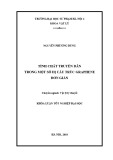


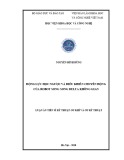

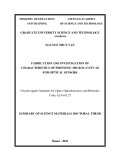
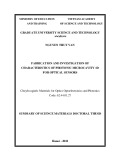

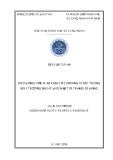


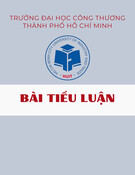
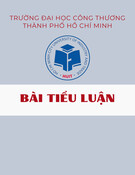
![Ô nhiễm môi trường không khí: Bài tiểu luận [Nổi bật/Chi tiết/Phân tích]](https://cdn.tailieu.vn/images/document/thumbnail/2025/20251011/kimphuong1001/135x160/76241760173495.jpg)







![Ứng dụng kỹ thuật trao đổi ion trong điện phân: Bài tiểu luận [chuẩn nhất]](https://cdn.tailieu.vn/images/document/thumbnail/2025/20250829/sonphamxuan1808/135x160/97341756442892.jpg)



